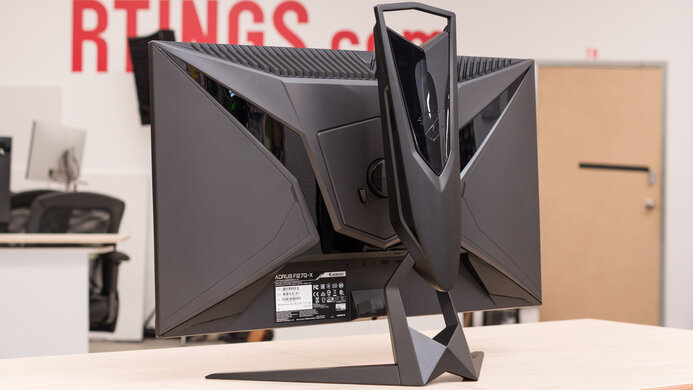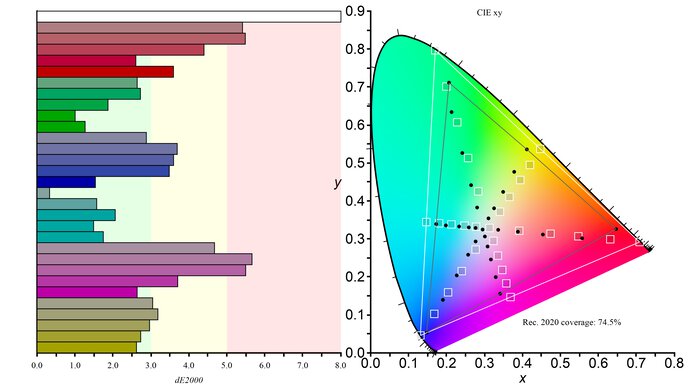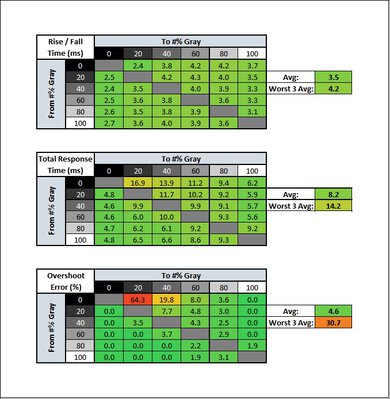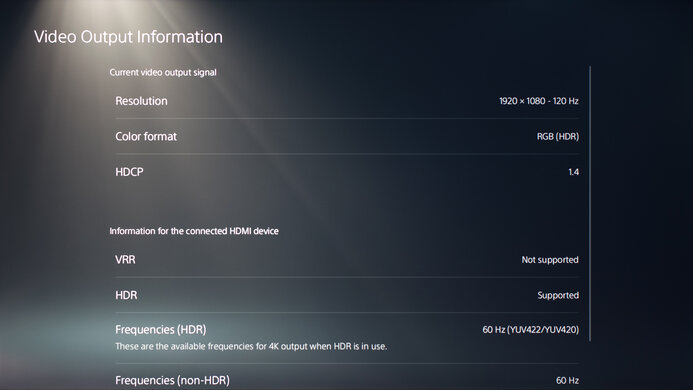The Gigabyte AORUS FI27Q-X is an excellent gaming monitor with a 27 inch 1440p screen and a high 240Hz refresh rate. Gamers should appreciate its FreeSync variable refresh rate (VRR) support and G-SYNC compatibility, and extremely quick response times for smooth motion. It has an IPS panel that offers wide viewing angles, but that comes at the cost of its low contrast ratio, so blacks look closer to gray. The panel uses a BGR sub-pixel layout, which is rare on monitors and more common on TVs. This doesn't affect picture quality, but not all programs can render text in the BGR format, so text may appear blurry. However, we don't expect this to be an issue for most people, especially if you use Windows ClearType to make text more legible.
Our Verdict
The Gigabyte FI27Q-X is great overall. It's excellent for gaming because it has a 240Hz panel with an incredible response time, low input lag, and VRR support. It's good for office use or content creators thanks to its large screen, wide viewing angles, and good ergonomics. Sadly, it's not the best choice for use in dark rooms as it has a low contrast ratio that makes blacks look gray.
-
27 inch screen and 1440p resolution.
-
Stand offers good ergonomic adjustments.
-
240Hz refresh rate with VRR support.
-
Very fast response time results in smooth motion.
-
Displays very wide color gamut.
-
BGR sub-pixel layout may not be used by all programs.
-
IPS panel has a low contrast ratio.
-
No local dimming feature.
-
HDR brightness is just okay.
The Gigabyte AORUS FI27Q-X is great for office use. It has a large 27 inch screen with a 1440p resolution to deliver clear text. The stand offers good ergonomics, allowing you to adjust it easily. It's a good choice for well-lit office spaces as it gets bright enough to combat glare and has decent reflection handling. Sadly, its BGR sub-pixel layout might cause blurry text in some programs.
-
27 inch screen and 1440p resolution.
-
Wide viewing angles.
-
Stand offers good ergonomic adjustments.
-
Displays very wide color gamut.
-
BGR sub-pixel layout may not be used by all programs.
-
No local dimming feature.
-
HDR brightness is just okay.
The Gigabyte AORUS FI27Q-X is excellent for gaming. It has a high 240Hz refresh rate that results in an incredible response time for smooth motion. It has native FreeSync support with G-SYNC compatibility, and the input lag is very low. Sadly, it's not the best for dark room gaming because its IPS panel has a low contrast ratio and bad black uniformity.
-
Stand offers good ergonomic adjustments.
-
240Hz refresh rate with VRR support.
-
Very fast response time results in smooth motion.
-
Very low input lag.
-
Displays very wide color gamut.
-
BGR sub-pixel layout may not be used by all programs.
-
IPS panel has a low contrast ratio.
-
No local dimming feature.
-
HDR brightness is just okay.
The Gigabyte FI27Q-X is great for consuming multimedia. It has a large screen with a 1440p resolution to deliver an immersive viewing experience. It has wide viewing angles, great if you want to view content with a few friends. Sadly, its low contrast ratio results in blacks that look gray when viewed in the dark.
-
27 inch screen and 1440p resolution.
-
Wide viewing angles.
-
Stand offers good ergonomic adjustments.
-
Displays very wide color gamut.
-
BGR sub-pixel layout may not be used by all programs.
-
IPS panel has a low contrast ratio.
-
No local dimming feature.
-
HDR brightness is just okay.
The Gigabyte AORUS FI27Q-X is great for content creators. It has wide viewing angles and good ergonomics, making it easy to share your screen with a coworker or client. The 27 inch screen and 1440p resolution offer enough space to multitask, but the BGR sub-pixel layout may not be used by all editing programs. On the plus side, it has perfect coverage of the Adobe RGB color space.
-
27 inch screen and 1440p resolution.
-
Wide viewing angles.
-
Perfect coverage of the Adobe RGB color space.
-
Displays very wide color gamut.
-
BGR sub-pixel layout may not be used by all programs.
-
No local dimming feature.
-
HDR brightness is just okay.
-
Displays very wide color gamut.
-
No local dimming feature.
-
HDR brightness is just okay.
- 8.0 Mixed Usage
- 8.1 Office
- 8.6 Gaming
- 7.5 Media Consumption
- 8.2 Media Creation
- 6.2 HDR
Changelog
- Updated Sep 15, 2022: We tested the monitor to confirm that it works with the PS5's new 1440p support.
- Updated Jul 12, 2022: Updated to Test Bench 1.2, resulting in changes to the results and scores with the Response Time and Input Lag. Added tests for Console Compatibility and macOS compatibility and made minor changes to other tests, which you can see in our Changelog.
- Updated Apr 23, 2021: We indicated that the refresh rate at 10 bit over DP is 144Hz, which is wrong. It's 200Hz.
- Updated Apr 23, 2021: Review published.
- Updated Apr 21, 2021: Early access published.
Check Price
Differences Between Sizes And Variants
We tested the Gigabyte AORUS FI27Q-X, which is only available in a 27 inch size. It's the newer version of the Gigabyte Aorus FI27Q and the Gigabyte Aorus FI27Q-P, which have a 1440p resolution and 165Hz refresh rate. If you have the FI27Q-X and notice it's different from ours, let us know. Note that some tests, like gray uniformity, may vary between units.
Our unit was manufactured in December 2020, and you can see the label here.
Compared To Other Monitors
The Gigabyte FI27Q-X is an excellent gaming monitor with one of the quickest response times we've tested on an IPS panel. If you're looking for a 240Hz, 1440p monitor and don't think its BGR sub-pixel layout will affect you, this is a good alternative to the Samsung Odyssey G7, but with wider viewing angles.
Also see our recommendations for the best 1440p monitors, the best gaming monitors, and the best monitors for photo and video editing.
The Gigabyte AORUS FI27Q-X is a nice upgrade over its predecessor, the Gigabyte AORUS FI27Q. The main difference of the FI27Q-X is that it uses a 240Hz panel compared to 165Hz on the FI27Q. This results in much quicker response time for smoother motion. The FI27Q uses an RGB sub-pixel layout, which may render text more clearly than the FI27Q-X in certain programs because not all programs can display content in a BGR sub-pixel layout.
The Gigabyte AORUS FI27Q-X and the Gigabyte M27Q (rev. 1.0) are both excellent gaming monitors with similar features. The FI27Q-X has a higher 240Hz refresh rate than the 170Hz on the M27Q, but they each have quick response times. The FI27Q-X has much better ergonomics as you can swivel and rotate it into portrait mode. On the other hand, the M27Q has a USB-C input, which the FI27Q-X doesn't have, so you can display an image from a compatible device and charge it at the same time.
The MSI Optix MAG274QRF-QD and the Gigabyte AORUS FI27Q-X are both excellent gaming monitors. They each have an IPS panel with a 1440p resolution, but the main difference is that the Gigabyte has a 240Hz refresh rate and the MSI has 165Hz. They have quick response times, native FreeSync support, and low input lag for gaming. The MSI uses a traditional RGB subpixel layout, whereas the Gigabyte uses BGR, which not all programs may use and could result in blurry text. However, we don't expect this to be an issue for most people.
The Gigabyte AORUS FI27Q-X is a better gaming monitor than the HP OMEN X 27, mainly because of its different panel types. The Gigabyte's IPS panel has much wider viewing angles than the HP's TN panel. It also gets brighter, so it fights glare easily in brighter rooms. However, the HP does a better job at rendering clear text, mainly because it uses an RGB sub-pixel layout compared to the BGR layout on the Gigabyte, and not all programs can use this layout.
The Gigabyte AORUS FI27Q-X and the Dell Alienware AW2721D are both great overall monitors with similar features. They're each 27-inch, 1440p screens with a 240Hz refresh rate. The Gigabyte has native FreeSync support, G-SYNC compatibility, and a quicker response time. However, the Dell gets much brighter, especially in HDR, and it has native G-SYNC support, but FreeSync also works on it. Choosing one over the other can really depend on which graphics card you have.
Test Results
The Gigabyte FI27Q-X looks exactly like its predecessor, the Gigabyte AORUS FI27Q. It has an all-black body with a gamer-oriented design. The stand is bulky and may stand out in an office environment but should look good in a gaming setup.
The Gigabyte AORUS FI27Q-X has great build quality. The plastic on the monitor feels very solid, and there's minimal flex throughout. The stand is metal and supports the screen well. The bottom bezel isn't attached uniformly across the screen, but it's hard to tell and shouldn't be a problem for most people.
The Gigabyte AORUS FI27Q-X has good ergonomics. It offers any type of adjustment, but some may find the swivel range a bit narrow. The back of the monitor is a mix of matte plastic with glossy accents, giving it a gamer-oriented design. There's RGB on the back panel and the stand. The cutout in the stand serves as cable management.
The metal stand has two wide-set feet that are far enough apart that you can place stuff in the front, like your mouse and keyboard. It holds the screen really well, and there's minimal wobble.
There's no local dimming feature on the Gigabyte FI27Q-X. The above video is for reference only.
The Gigabyte AORUS FI27Q-X's SDR brightness is great. It easily gets bright enough to combat glare, and it's very consistent across different content.
We tested the SDR peak brightness after calibration in the 'Custom 1' Picture Mode with Brightness at max.
The Gigabyte FI27Q-X has okay peak brightness in HDR, and it's a slight improvement over the Gigabyte AORUS FI27Q. It meets the brightness requirement of its DisplayHDR 400 certification, but it still may not be bright enough to truly bright out highlights in HDR content.
When you enable HDR On you can't change any picture settings.
The Gigabyte FI27Q-X has very wide horizontal viewing angles, which is expected from an IPS panel. It's a great choice for co-op gaming, but you may notice a bit of color washout at very wide viewing angles.
Once again, the vertical viewing angles are excellent. The image remains accurate if you mount it above eye level, but you may still see some color washout.
The Gigabyte AORUS FI27Q-X has excellent gray uniformity. The edges are a bit darker, but there's no dirty screen effect in the center. Uniformity is improved in near-dark scenes, but some backlight bleed is noticeable at the top right corner. Keep in mind that uniformity can vary between units.
Our unit of the Gigabyte FI27Q-X has bad black uniformity, but this can change from unit to unit. Due to its low contrast ratio, the entire screen looks blueish/gray. There's also noticeable backlight bleed and clouding throughout, which is distracting in dark scenes.
The out-of-the-box accuracy is great. Most colors are only slightly inaccurate, but not enough to notice, and the same can be said about the white balance. However, color temperature is on the cold side, resulting in a blue tint. Gamma doesn't follow the sRGB target curve at all, resulting in all scenes being brighter than they should. Keep in mind that out-of-the-box accuracy can vary between units.
The Gigabyte FI27Q-X's accuracy after calibration is remarkable. Any remaining color and white balance inaccuracies can't be spotted by the human eye, and the color temperature is extremely close to the 6500K target. Gamma is improved, but you still may notice that really dark and really bright scenes are slightly over-brightened.
The Gigabyte AORUS FI27Q-X has an exceptional SDR color gamut, better than any monitor we've tested. It has perfect coverage of both the sRGB color gamut used in most content and the Adobe RGB color space used in photo or video editing.
This isn't the first time we've tested a monitor with such full coverage of the Adobe RGB color space. Monitors like the MSI Optix MAG274QRF-QD, Acer Predator X27 bmiphzx, and the Gigabyte M27Q (rev. 1.0) have at least 97% coverage. All of these monitors, including the FI27Q-X, achieve this by over-saturating the colors, which makes them look inaccurate.
The Gigabyte FI27Q-X has an excellent HDR color gamut. Unlike most monitors, its DCI P3 color space matches exactly the advertised 93% coverage, which is great for watching most HDR content. Its coverage of the wider Rec. 2020 is also good, so it displays most colors needed for HDR content.
The Gigabyte AORUS FI27Q-X has an okay HDR color volume, but it's lower than expected considering its excellent HDR color gamut. This is because of the way we test for it and how the monitor responds to the testing. In our HDR color gamut tests, we use a 50% stimulus, and with this monitor, that results in the wide color gamut measurements because colors appear as they should. However, when using a stronger stimulus, less-saturated colors start to appear white, and at 100% stimulus, only the primaries are visible as colors, with everything else appearing as white. The color volume is lower than expected because of how most colors appear white at the 100% stimulus. This means that really bright content in HDR content can lose fine details as colors may appear closer to white.
You can see the Rec. 2020 gamut measurements at different stimuli below:
The matte finish has decent reflection handling, similar to the Gigabyte AORUS FI27Q. It handles a moderate amount of light well but struggles with a ton of light on it. We suggest avoiding placing it opposite a window with direct sunlight.
Unlike most monitors, the Gigabyte AORUS FI27Q-X uses a BGR sub-pixel layout instead of RGB. Text clarity is still good if you enable Windows ClearType (top photo). The BGR sub-pixel layout doesn't affect image quality, but it can hurt text clarity in certain programs that don't use Windows ClearType. It shouldn't be an issue for most people, but if you notice that text still looks blurry, you can turn the monitor upside down, which results in a proper RGB format. However, this could come at the cost of increasing the input lag or having VRR issues.
If you want to learn more about the BGR layout, we tested it with different scaling options, and on a MacBook in various programs with the Gigabyte M27Q (rev. 1.0), which you can read about here.
The Gigabyte FI27Q-X has native FreeSync support and is certified as G-SYNC compatible. Although both AMD and NVIDIA certify the VRR to work over DisplayPort from 48Hz and above, we verified that it works at an even lower refresh rate. Over HDMI, the VRR range is from 20 to 144Hz, and only FreeSync works.
| Overdrive Setting | Response Time Chart | Response Time Tables | Motion Blur Photo |
| picture-quality | Chart | Table | Photo |
| balance | Chart | Table | Photo |
| speed | Chart | Table | Photo |
The response time at the max refresh rate of 240Hz is simply incredible. Motion looks buttery smooth, and there's isn't any obvious motion blur. The recommended Overdrive setting is 'Balance' because it's quicker than 'Picture Quality' and has a lot less overshoot than 'Speed'. However, there's some overshoot in the 0-20% transition, so if you tend to game with dark scenes and notice it, use 'Picture Quality' instead.
| Overdrive Setting | Response Time Chart | Response Time Tables | Motion Blur Photo |
| picture-quality | Chart | Table | Photo |
| balance | Chart | Table | Photo |
| speed | Chart | Table | Photo |
The Gigabyte AORUS FI27Q-X's response time at 60Hz is also fantastic. The total response time with the recommended Overdrive setting of 'Picture Quality' is just a bit slow, so you may notice some motion blur, but there's no overshoot. This also means you would have to change the setting if the frame rate of your game drops.
The Gigabyte AORUS FI27Q-X has a backlight strobing feature, commonly known as black frame insertion, to try to improve the appearance of motion. It flickers within a narrow range and can't be used with VRR enabled.
The input lag of the Gigabyte FI27Q-X is extremely low, and it stays low with VRR enabled.
The Gigabyte FI27Q-X has a great 27 inch screen with a high 1440p resolution. This is ideal for multitasking as you can easily open multiple windows side-by-side.
The USB inputs are advertised to supply 5V/1.5A of power if you have the USB-B upstream cable connected to a PC.
This monitor works well with recent MacBooks. The variable refresh rate feature works well both in-game and on the desktop. Windows return to their original place when you wake the computer from sleep, but not if you close the lid. HDR works, but the mapping is a little weird, so it doesn't look very good.
The Gigabyte AORUS FI27Q-X has a bunch of extra features, including:
- ANC: Active noise cancelling to reduce background noise when you speak into the microphone, but we didn't test this.
- Black Equalizer 2.0: Raises the gamma so that you can see objects in dark games.
- Crosshair: Adds a crosshair for FPS games.
- Dashboard: On-screen display to show your computer's status, like the temperature.
- Display Alignment: Displays a grid to help you align the monitor for multi-monitor setups.
- Frame Rate Counter: Displays the current frame rate.
- OSD Sidekick: Allows you to change the monitor's settings using your mouse and keyboard instead of the monitor's physical button. The USB-B upstream cable needs to be connected to your computer for it to work.
- PiP/PbP: Picture-in-Picture and Picture-by-Picture modes so that you can display an image from two sources at once.
- RGB Bias Lighting: RGB lighting on the back of the monitor, which can be controlled with the RGB Fusion 2.0 software.
- Timer: Displays a timer on the screen.
Comments
Gigabyte AORUS FI27Q-X: Main Discussion
Let us know why you want us to review the product here, or encourage others to vote for this product.














































































































